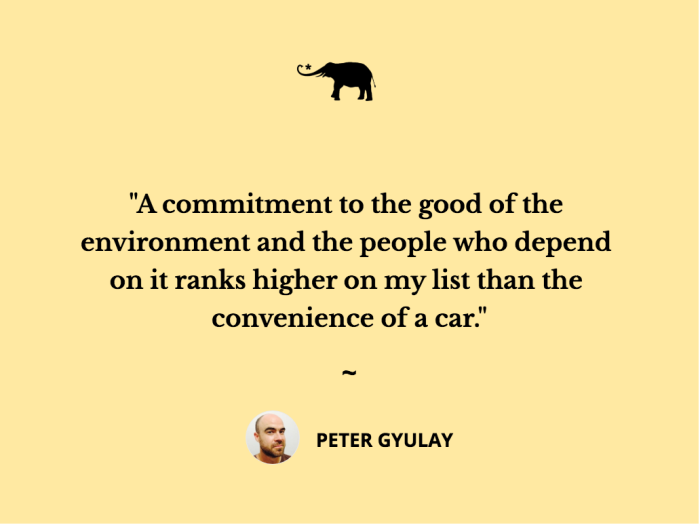View this post on Instagram
Anyone living in a city knows deep down that taking public transport is a way to help the environment.
But our cars are so comfortable and convenient! In some places there’s even a stigma attached to riding the bus or train.
These factors might lead us to cover up our consciences and tell ourselves that driving everywhere is absolutely essential. I’m not here to tell you to get rid of your car. But I’d like to point out some benefits to taking public transport.
In 2014, my wife, son, and I joined the 82 percent of the world who don’t have a car. Most of that time has been in Sydney where public transport, though not perfect, is quite plentiful. Some of these examples are general while others might pertain more to cities similar to Sydney.
Getting to a crowded place
There’s often a reason that places are crowded and tourist attractions are both touristy and attractive; there’s something genuinely awesome about them that makes people want to go there. One such place in Sydney is the beach (actually, any of the beaches).
From where we live, it takes about 30 minutes to drive to the beach and one hour to get there by bus and/or train. At a glance, that looks like double the time! But it’s not.
Sydney beaches are crowded, and if you are like me and don’t want to spend $20-30 on parking, you could easily spend 30 minutes driving around the beach trying to find a place to park for free and then have to walk 10-15 minutes back to the beach. So, from stepping out our front door and onto the sand, the time is about the same, whether travelling by car or public transport.
(To my surprise, there was an exception to this. Recently, we rented a hybrid and drove to the beach. I started on my regular rounds of trying to find free parking and found a green-colored car space right near the beach, free of charge for hybrids. Great to see! But also hard to find.)
Getting to work
We can’t always live where we work. I regretted this fact years ago when I had to commute almost two hours each way to work and back. I can remember walking out of work in the winter when the sun was almost setting, looking at a hedge on the side of the road and thinking, “Why don’t I just sleep behind that hedge? I will just have to come back here in the morning!”
But I persisted on my commute, which also included a one-hour, 15-minute train ride. That’s two and a half hours a day that I had at my disposal. At first, I used that time to read and meditate, but then I decided to do my Masters online. And that was all the time I had. I did 95 percent of the work on the train. I couldn’t have done that if I had been driving to work.
Even if you’re not studying, just being able to switch off after work is so healthy and safe. On the days I didn’t have to study, I would have a nap on the way home. Those people driving, on the other hand, risk having a car accident because they might nod off to sleep.
Going that way anyway
Bus versus Uber: they both drive on the road, but Uber is usually faster than getting a bus because it’s more direct and it doesn’t have to stop for passengers. So, what could be the reason to choose the bus instead? The bus is more eco-friendly. “But they both produce co2!” Yes, but more people take the bus, so the co2 is used to transport more people.
It’s also important to remember that the bus is “already going that way anyway” whereas the Uber is only going that way if I book it. So why not jump on the bus that’s already passing through instead of calling the Uber to come just for me?
Of course, there are times when an Uber is a must. When I snapped my Achilles tendon a few years ago, I didn’t catch a bus to the hospital; I got an Uber. (I’m not saying you have to break a body part to justify an Uber!)
Meeting people
Car-crowded cities are notoriously anti-social. People go from home to garage to car to work to garage to home. They may not even need to go outside or talk to anyone besides their family or co-workers. This means only seeing people from the same strata of society.
But if we take public transport, we have the chance to mingle with people from all walks of life. We can have all sorts of random and meaningful encounters with people. I’ve had many myself. For example, on one train trip, I got to talk to a PhD student doing research on bees.
Voting with your butt
By catching a bus or train, the money you pay to put your butt on a seat is telling the government that you support public transport. The more people who take public transport, the cheaper and more efficient it will become.
In the city Newcastle where I grew up, almost no one uses the bus. How often does the bus come? Every hour. Why don’t they have more frequent buses? Because not enough people use the bus. So, if more people used the buses, there would be more buses running.
In places like China, there are buses every few minutes on the same route because there are so many people using them. Yes, China has a huge and highly dense population, but there are also a much smaller percentage of people who own their own car and hence a much higher percentage of people who use public transport.
I’m not saying that public transport is always the easiest way to get around. It can be challenging, and I must admit that I am often tempted to get a car so that when I have the urge to go from A to B, I can jump in and go.
But I also know that a commitment to the good of the environment and the people who depend on it ranks higher on my list than the convenience of a car. Why don’t I get an electric car? I’m looking into it. But from what I can see about our particular circumstances, it wouldn’t be that eco-friendly.
We are renting and don’t have solar panels, so the electric car would have to be powered by coal-generated electricity. That’s not solving anything.
So, for now, we are sticking with the car-less life. What helps me maintain this commitment is to look at the positive aspects of living without a car.
~











Read 1 comment and reply